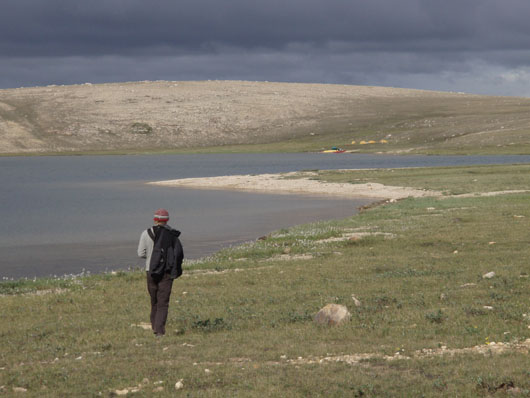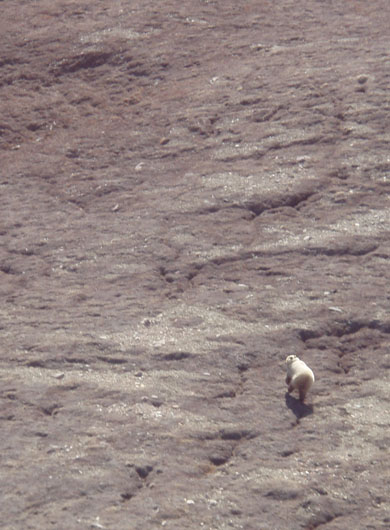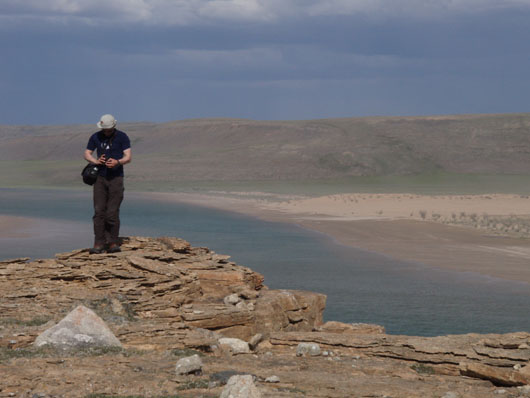 |
 |
|
 30.01.2008: The Bear Truth
30.01.2008: The Bear Truth
What about the dangers of bear, you ask? That's a very good question, and one that I myself had to take some time figuring out because the responses are vague and sometimes inconsistent. The ranges of both polar bear and grizzly bear extend over the landscape around Paulatuk. The latter often surprises people, wondering what they are doing so far from treeline. These are barren-ground grizzly bear and they make their home on the tundra. Polar bear are found all around the Arctic Ocean, and may be encountered in and around nearly every arctic community. They are predators, and if they are hungry they will not think twice about stalking you for dinner. This makes the prospect of walking alone, unarmed outside of most communities a somewhat risky undertaking. I cannot speak personally of other communities, but this is my understanding from what I've read and heard from a number of sources. Grizzly bear in this area are active from about April until late September, and hibernate through the winter. In the fall when they are very active foraging and bulking up for the long winter hibernation, grizzlies frequently wander very close to town, leaving behind their ominous footprints along the beaches. They are large, and when sighted their size can be very impressive especially since there is not much around them to distinguish their size, other than their hulking bodies. Locally there is a deep, healthy respect for the grizzly, which has served the Inuvialuit people well over many hundreds of years of coexistence. I do feel, however, that this respect has in many instances developed into irrational fear about the animals. This is not without reason: all wild animals are unpredictable, and many frightening stories exist of encounters with people experienced on the land. One local tale tells of grizzly bears stalking people, "lying flat to the ground and invisible to the eye, waiting to jump up and kill you." Most people will not go to a camp for any extended time without dogs tied nearby to warn of approaching animals, and almost no-one will go out without a gun, period. It is not my intention to discredit the stories I have heard - I believe that when dealing with local knowledge, or traditional knowledge, there are truths to be learned. What does a white girl who's been here only two years know anyway? Aboriginal stories often have lessons that are to be interpreted differently than the way non-aboriginal cultures tend to see them. Still, I also think there is something to be understood when there are people afraid to walk through town for fear of grizzly bear hunting them down. I think we all need to come to our own understandings, and this is mine.
Grizzly bear in the arctic behave much like those in the forest. I had guessed as much, but was satisfied when a biologist who had worked many years with grizzly bears in the north told me the same. When being aggressive, they are unpredictable, intimidating and can easily kill. However, unless they are very hungry or starving, sick or a mother with cubs taken by surprise, they are not likely to attack people. In fact, they are also unlikely to approach occupied camps as many know that the presence of people is not generally good news. Of course, in the vastness of this wilderness, experiences with people are limited and bears can be brazen, but still the tenets generally hold true. With any wild animal there is an element of risk, but those associated with grizzly bear in the arctic are the same as those in the forest. I have been comfortable in the past undertaking extended hiking trips alone in forests inhabited by grizzly bears, and so once establishing that bears here are no different I became comfortable with the idea of venturing here without a gun. If we take anything, Markus and I take only bear spray as a last-resort defense during over-night camping trips, and prefer to take our chances and accept the consequences than live a life restricted to the limits of our community or by the weight of a gun. It has always been that way with me since I first started doing my own wilderness trips alone. I accept that others, certainly many if not all locals, would consider that suicidal. If you are interested in further information on what to do when confronted by a bear, I suggest you visit Safety in BEAR COUNTRY.
Polar bear do live near Paulatuk and they are part of the important local livelihood of guided sport hunting in the springtime. In the winter when the Arctic Ocean freezes they are hunting on the sea ice and can travel along coastlines. Generally, it is my understanding that in the summer males and non-breeding females stay on the year-round pack ice out to sea and further north. Breeding females move to the land and in places like Churchill, Manitoba, have been found up to 100km inland denning. They forage along the coastal land for food until giving birth, and then restrict their movement to stay in the den with their young through the winter until they are large enough to travel in the spring. If you have looked at a map of where we are, you have seen that Paulatuk is tucked down at the very bottom of the large Darnley Bay. Polar bear prefer access to the open ocean, as there are more fish and seals available and they hunt by swimming as well as "pouncing" (hearing seal pups or adults at a den or breathing hole under the ice and snow, and lunging on the prey from above). They depend on open water for their hunting, and in the winter when most water freezes they will follow ice leads (open cracks in sea ice), floe edge (edge between fixed ice and broken up, shifting, moving ice) or stay near polynas (year-round open water caused by upwelling currents in the ocean). Darnley Bay does not see the open-sea weather and current disturbances that the ocean does, and it tends to freeze over quite solidly. That being said, we enjoy the absence of polar bears in and around our community for tens of kilometers which is a rarity in the north. Guides with sport hunters travel over fourty kilometers to reach polar bear habitat. In the seventies a polar bear wandered in to just behind town, and in the mid-eighties a polar bear came to within seven kilometers of town. Otherwise, there are no records of polar bear coming anywhere near here. They stay further north, outside of the bay. (If you are interested in further information on polar bear encounters, I suggest you visit Safety in POLAR BEAR COUNTRY). This means that in the winter time bear are not a concern to us while travelling and camping. In the summer (spring/summer/fall) while travelling inland, we must be aware of grizzly bear, but choose not to be paranoid. A healthy respect and understanding of bear behaviour is a must, as well as knowledge of what to do in a confrontational situation. Happy trails! -Delia
Recently archived stories:
:: 21.01.2008: What do you mean, you don't have a TV? :: 10.11.2007: Do it yourself - the Water Tank Adventure :: 02.09.2007: Slideshow - Delia's Winter '06-07 reunion with friends :: 26.08.2007: Photos - Delia's Mom's Visit :: 26.08.2007: Update - Park Patrol Trip :: 17.06.2007: Photos - Fall to Winter '06 and Yukon '07 :: 31.05.2007: Springtime Update :: 20.11.2006: Musings Of The Dark :: 1-4.8.2006: One Island Lake Youth Camp 2006: Fun in the sun :: 04.9.2006: Little Salmon Lake trip: hungry rocks eat lure, poles mysteriously missing :: 13.9.2006: Park Familiarization Trip: Getting a little too familiar... :: 08.9.2006: Starting off fresh
|



